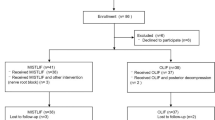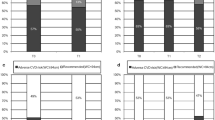Abstract
Insensible weight losses (IWL) were determined in each of 24 patients with physiologically complete spinal cord transection. The patients were placed on a bed balance with an accuracy of ± 5 g in an environmental chamber maintained at 24°C. dry bulb and I7°C. wet bulb temperature. Bihourly weight changes, corrected for food and fluid ingestion, were determined for a total of 24 hours. Tetraplegics have significantly lower (P<o.05) IWL than paraplegics. The IWL of paraplegics are in the range of IWL of normal persons reported in the literature. We conclude that a lower allowance for IWL should be made for tetraplegics than for paraplegics or persons with intact spinal cords
Similar content being viewed by others
Log in or create a free account to read this content
Gain free access to this article, as well as selected content from this journal and more on nature.com
or
References
Bard, P (1968). Body temperature regulation. In: Medical Physiology, V. B. Mountcastle (editor), C. V. Mosby, St Louis, 12th edition, pp. 553–590.
Benedek, T (1939). Cantharides blister and its application in microbial research; review of literature and some suggestions. J. Trop. Med. Hyg. 42, 81–86.
Bergofsky, E H (1964). Quantitation of the function of respiratory muscles in normal individuals and quadriplegic patients. Archiv. Phys. Med. Rehabil., 45, 575–580.
Bettley, F R & Grice, K A (1967). The influence of ambient humidity on transepidermal water loss. Br. J. Dermatol, 78, 575–581.
Brebner, D F, Kerslake, D Mck & Waddell, J L (1956). The diffusion of water vapour through human skin. J. Physiol. (London), 132, 225–231.
Burch, G E (1945). Rate of water and heat loss from the respiratory tract of normal subjects in a subtropical climate. Arch. Intern. Med. 76, 315–327.
Burch, G E (1946a). The rates of water and heat loss from the respiratory tract of patients with congestive heart failure who were from a subtropical climate and resting in a comfortable atmosphere, Am. Heart J, 32. 88–89.
Burch, G E (1946b). Influence of variations in atmospheric temperature and humidity on the rates of water and heat loss from the respiratory tract of patients with congestive heart failure living in a subtropical climate, Am. Heart J. 32. 190–201.
Burch, G E & Winsor, T (1944). Rate of insensible perspiration (diffusion of water) locally through living and through dead human skin. Arch. Intern. Med, 74, 437–444.
Cutting, W C (1969). Handbook of Pharmacology. Meredith Publishing Co., New York, 4th edition.
D'Alton, C J, Darling, R C & Shea, E (1948). The insensible loss of water in congestive heart failure. Am. J. Med. Sci. 216, 516–522.
Grice, K & Bettley, E R (1967). The effect of skin temperature and vascular change on the rate of transepidermal water loss. J. Invest. Dermatol. 79, 582–588.
Grice, K, Sattar, H & Baker, H (1972). The effect of ambient humidity on transepidermal water loss. J. Invest. Dermatol. 58, 343–346.
Grice, K, Satter, H, Sharratt, M & Baker, H (1971). Skin temperature and trans-epidermal water loss. J. Invest. Dermatol, 57, 108–110.
Goodman, A G & Wolf, A V (1969). Insensible water loss from human skin as a function of ambient vapor concentration. J. Appl. Physiol, 26, 203–207.
Hardy, J D, Stolwijk, J A J & Gagge, A P (1971). In Comparative Physiology of Thermoregulation. Mammals. G. C. Causey (editor). Academic Press, New York, volume 2, pp. 327–380.
Mitchell, J W, Nadel, E R & Stolwijk, J A J (1972). Respiratory weight loss during exercise. J. Appl. Physiol. 32, 474–476.
Newburgh, L H, Wiley, F H & Lashmet, F H (1931). Method for the determination of heat production over long periods of time. J. Clin Invest, 10, 703–721.
Pinson, E A (1942). Evaporation from human skin with sweat glands inactivated. Am. J. Physiol, 137, 492–503.
Shahidullah, M E, Raffle, S & Fraih-Bell, W (1967). Insensible water loss in dermatitis. Br. J. Dermatol. 79, 589–597.
Steel, R G D & Torrie, S H (1960). Principles and Procedure of Statistics. McGraw-Hill, New York, pp. 109–110.
Taylor, C L & Buettner, K (1953). Influences of evaporative forces upon skin temperature dependency of human perspiration. J. Appl. Physiol. 6, 113–123.
Thiele, F A J & Van Senden, K G (1966). Relationship between skin temperature and the insensible perspiration of the human skin. J. Invest. Dermatol. 47, 307–312.
Wilson, J S & Moncrief, S A (1965). Vapor pressure of normal and burned skin. Ann. Surg. 162, 130–134.
Author information
Authors and Affiliations
Rights and permissions
About this article
Cite this article
Kuhlemeier, K., Miller, J. & Nepomuceno, C. Insensible weight loss in patients with spinal cord transection. Spinal Cord 14, 195–201 (1976). https://doi.org/10.1038/sc.1976.34
Issue date:
DOI: https://doi.org/10.1038/sc.1976.34



